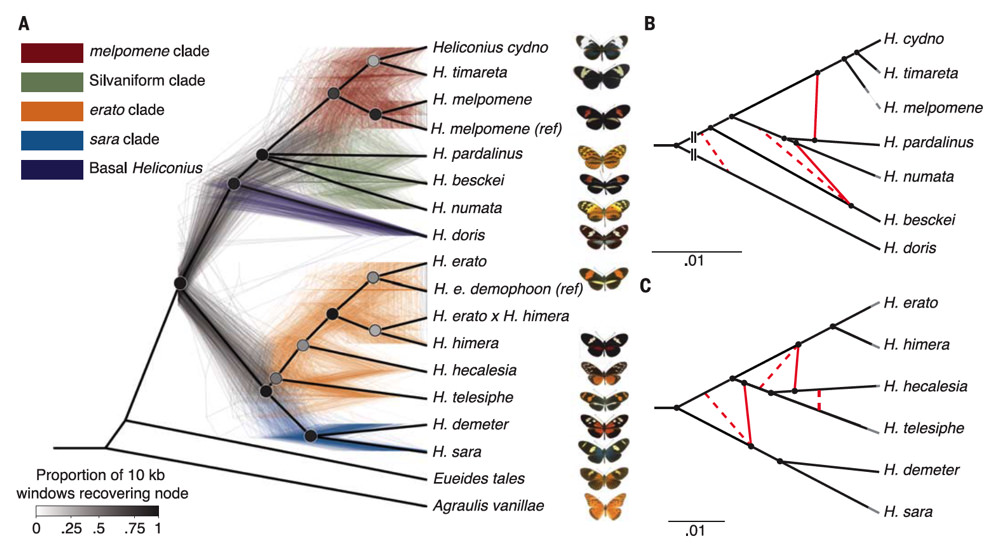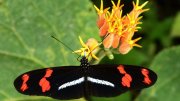The diverse patterns of fiery reds, bright yellows, and iridescent blues on the wings of Heliconius butterflies warn predators away from the foul-tasting, poisonous insects. But the same colors that drive away predators bring biologists flocking to study them. Victorian-era naturalists tracing how different species within this genus mimic each other provided sorely needed support for Darwin’s just-published theory of natural selection. And now, more than 150 years later, the genes behind these same color patterns are showing that the definition of a species is more complicated than Darwin could have dreamed.
A study published by an international team today in Science shows that genes flowing among the 40-some different species of Heliconius have played a critical role in their success and diversity. Such gene flow occurs when a hybrid between two species breeds with one of its parent species, adding to that species’ gene pool the genes from the other parent species, in a process known as introgression.
Though introductory biology classes may teach that two species are not distinct if they produce fertile hybrids, scientists have long known of exceptions: from Darwin’s finches to tomatoes, hybrids can play a key role in forming new species, and well-known “sterile” hybrids like mules and ligers are occasionally fertile. Over millions of years, even the rarest exceptions happen enough times to leave a mark. In fact, our own DNA contains evidence that humanity’s ancestors and those of chimpanzees continued swapping genetic material for millions of years after their first divergence (see “Genetics and the Human Revolution”). But the new study, led by researchers in the lab of professor of organismic and evolutionary biology in residence James Mallet, shows just how common such hybridization can be, and that it can play an important role in helping species adapt to their environment.

Genes continue to flow between species long after those species separate. This figure shows 500 different evolutionary trees for the genus Heliconius, each inferred from a different portion of the butterflies’ genome.
Reprinted with permission from Nathaniel Edelman, et al., Science 366:594 2019.
“Just as sex probably improves fitness because it allows different gene combinations to be tried out,” said Mallet, “when you have occasional sex between species this also brings in potential adaptive variation from multiple different adaptive niches.” In particular, the team found that a genetic feature related to color patterning had independently occurred two different times in Heliconius’ past—but then had been passed from one species to another multiple times, allowing many different species to mimic each other’s colors.
To understand exactly how Heliconius evolved, the team had to compare the species’ DNA in a more complicated manner than the usual bit-by-bit comparison of corresponding gene sequences. Typical comparisons can point to small changes in a sequence—a deletion or replacement at a single point, for instance. But they miss larger, “structural” changes, as can happen when a large section of DNA is duplicated, reversed, or deleted in its entirety. So instead of only looking for small changes in DNA, the team sequenced the entire genomes of 20 different butterfly species from scratch, giving them full “genome assemblies” that showed not only the sequence of each gene, but how they fit together.
“The entire structures of genomes can change in evolutionary time,” said first author Nathaniel Edelman, a doctoral student in organismic and evolutionary biology, in a statement accompanying the discovery. “And using the assemblies, we can detect these changes.”
These structural changes are the result of recombination, the scrambling of a parent’s genetic material that occurs before half of it is passed to offspring. This allows genes from a hybrid to become incorporated into their parent species’ chromosomes. Even though individual hybrids are rare, the authors found, over millions of years the effects of this introgression can be dramatic—about 20 percent of the genes throughout the genus are the result of introgression. “The evolutionary tree of butterflies is a complete morass of interconnectedness,” said Mallet in the news release. “Every bit of the butterfly genome seems to have a different tree."
Different parts of the genome are recombined at different frequencies, for reasons ranging from the length of the relevant chromosome to the ability of the gene to function outside its parent species. “Often in hybridization, genes that are from different species don’t work well together,” Edelman explains, “but if you break up the genome into tiny, tiny pieces, then you can select out the bad stuff and keep the good stuff. We find in parts of the genome where there’s more of this recombination, you get more introgression, because you can decouple the bad stuff from the good stuff.”
Recombination can also produce entirely new structures, which hybridization can then carry between species. One of these structural changes shows one way that the mimicry that so fascinated Victorian scientists may work. Distantly related species can mimic each other through convergent evolution, the phenomenon of natural selection slowly prodding their genomes towards similar traits. But these butterflies have a simpler route: simply borrow DNA from a nearby species. The colors of several Heliconius species are regulated by a section of DNA whose direction was reversed from that same section in the ancestral genome. Similar “inversions” happened at least twice in different lineages—but one of these inversions has been passed between species through hybridization. This enables many different species to use the same color patterns, making a warning that is more recognizable to predators.
The results point toward a new idea of species—not entirely different from what Darwin imagined, but one that depends on the changing ecological context as much as genetic measures. “What I believe a species is,” says Mallet, “is a population of individuals that can remain distinct while in contact,” even with some interbreeding.
“It’s really hard to define a species based only on genetic data, because there’s not a set amount of differentiation you have to have before you’re a different species,” elaborates Edelman. “I think this test of overlap is a good one, but that requires ecological data, field data.”
And it results in an unsettling possibility: for two populations that don’t naturally overlap, there may be no right answer to whether they are one species or two.









